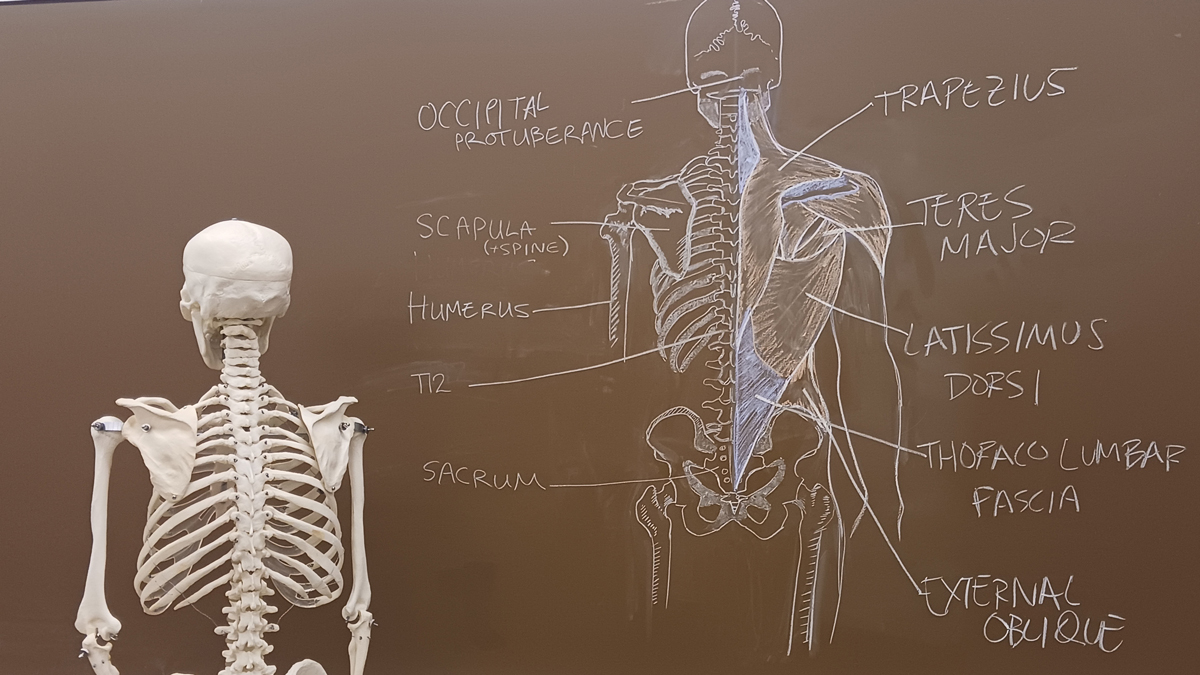
Students have an opportunity to study and learn to create anatomically accurate and artistic drawings, such as the one by SIU Carbondale MFA graduate McKenzie Graham, during a four-day pilot workshop in July in the university’s cadaver laboratory. (Photo provided by McKenzie Graham)
June 22, 2023
SIU melds art and science with anatomical drawing workshop July 13-16
CARBONDALE, Ill. — A pilot workshop next month at Southern Illinois University Carbondale will give participants a chance to discover a longstanding Renaissance era tradition of artistic anatomy by studying cadavers and learning from human anatomy and medical experts.
The intensive four-day Artistic Anatomy Drawing Workshop, July 13-16, melds the arts and sciences and is designed for artists age 18 and older who are interested in studying and creating anatomically accurate and artistic drawings from direct observations of cadavers. This is the first time SIU has offered the workshop.
“It is extremely rare for artists and medical students to have access to such an opportunity to improve their understanding of the human form,” said Antonio J. Martinez, an associate professor of photography and intermedia arts in the School of Art and Design. “Drawing requires active observational skills, coupled with a continuous examination and re-examination of the structure and intricacies of the human body.”
The summer workshop will be led by Jonathan Krimsier, a physiology instructor in SIU’s School of Medicine on the Carbondale campus, and McKenzie Graham, who graduated in May 2023 with a Master of Fine Arts. Krimsier and Graham hosted a couple of impromptu drawing sessions for interested students and staff on campus last fall, and Martinez said the hope is the workshop expands to more offerings or possibly an academic course for both pre-med and art students.
Media Advisory
Reporters, photographers and news crews who are interested in the workshop should contact Antonio J. Martinez, associate professor of photography and intermedia arts in the School of Art and Design, at antonio.martinez@siu.edu or 618-559-6483. Please note the cadaver lab has a strict policy about no photographing of bodies.
Recapturing the past
The registration deadline is July 5, and the class size is limited; residential and commuter packages are available. Learn more about registration.
The workshop is for anyone interested in drawing and studying the human form, Martinez said, noting that a biology teacher with no drawing skills recently registered, as did a high school student wanting a more challenging summer art workshop.
Krimsier notes that 200 years ago the artist and scientist “were either the same person or best friends, and somewhere along the way, we went into our separate fields. The workshop is trying to return to that friendship.”
He hopes students leave with a “new or deeper appreciation of the human body.”
“We will cover some of the basics of anatomy, terminology, actions of muscles, fiber orientation of muscles,” he said. “The goal on my end is to leave them with enough anatomy that they can build upon throughout the years without overwhelming the students.”
Graham said the workshop will include her illustrating Krimsier’s lectures as he names the bones, muscles and other details, and she will also discuss certain artistic techniques. Students will create drawings based on their observations of cadavers in the afternoon.
Rare opportunity
Graham, a classically trained artist who attended the Lyme Academy College of Fine Arts, explained that drawn lectures are rare “but exceptionally engaging.”
“I've never heard of a workshop or class being co-taught like this with an actual anatomy professor and an artist live-drawing, and I looked for one myself the last few years,” she said.
“Opportunities like this are extremely rare and very valuable to artists. Representational (realistic) artists who like the classical style or just like to draw human figures jump at this type of opportunity. Most artists will never have access to a cadaver, as it is so tightly regulated and there are so few.”
Martinez sees benefits for both art students and non-art students, including the general public.
“For art students, it will improve their technical skills and rendering of the human form more accurately. Being able to see the underlying layers and structures beneath the skin informs accurate placement of joints, muscles and tendons versus making an educated guess,” he said. “For non-art students, hopefully the joy and wonder of drawing will be ignited and lead to a new hobby. For a medical student, it will sharpen their attention to detail of the human form.”
Cadavers are important educational gifts
One male and two female cadavers in various states of dissection will be used to show a variety of structures of the human body, Krimsier said. They are in their own dedicated lab space in Lindegren Hall and were donated to the school for use by the donors and their families.
“We use the cadavers as the gifts that they are to educate nursing, medical, art, undergraduate, graduate and high school students,” he said. “I fully believe that by utilizing the cadavers to educate as many people as possible we are fully utilizing the invaluable gift we have been given. We thank the individuals and their families for their generosity.”
